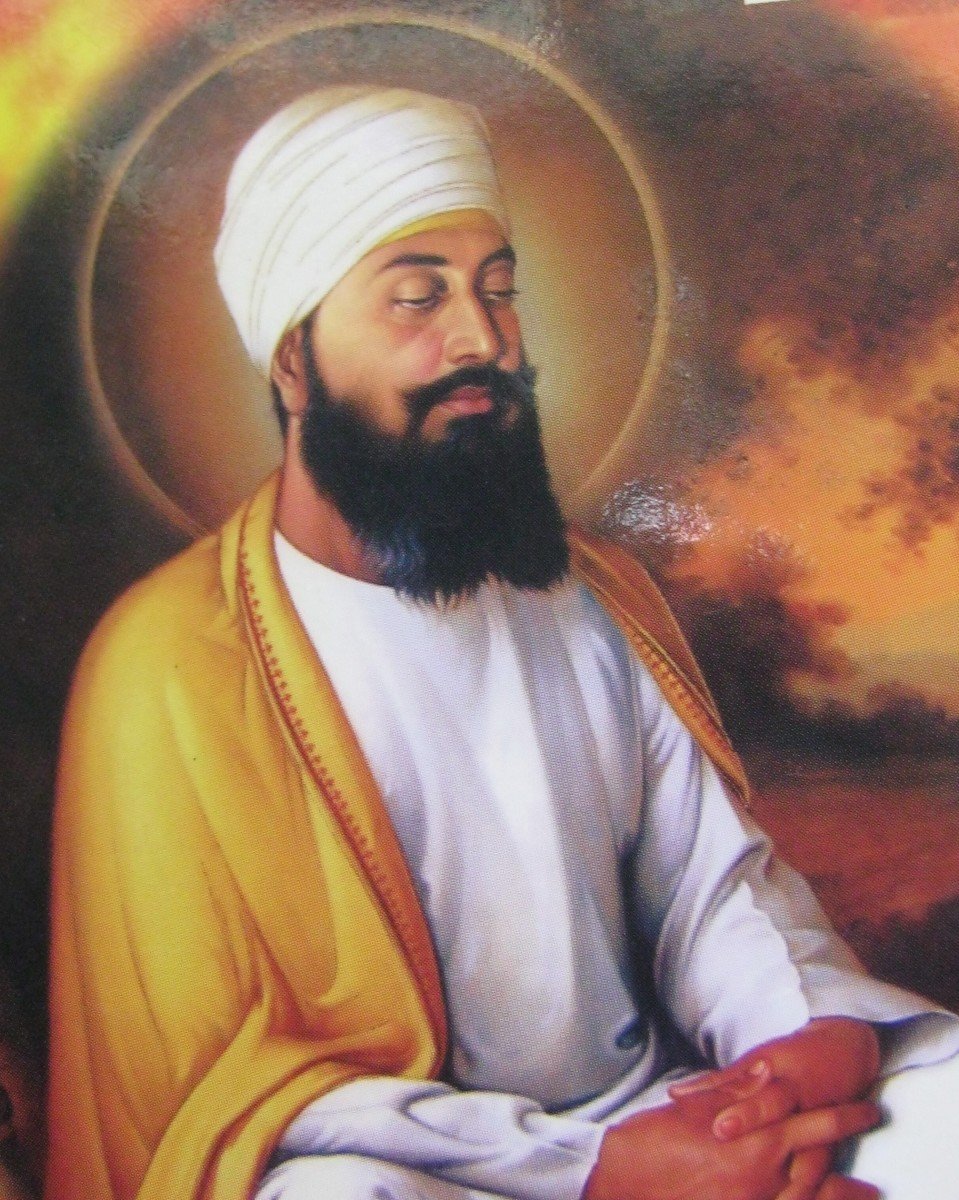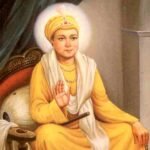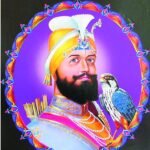Guru Tegh Bahadur Ji
Guru Tegh Bahadur Ji established Anandpur Sahib – the Haven of Bliss. He made supreme sacrifice to protect the Hindus and accepted execution instead of converting to Islam.
| Name of Guru | Sat Guru Tegh Bahadur Ji, Sodh Linage aka Sodhi Bans |
|---|---|
| Birthplace | Gurudwara Guru Ke Mahal, Sri Amritsar Sahib |
| Birthday | 1678 Bikrami Vaisakh Vadi 5th, Day Tuesday, April 12th, 1621 CE, Visakha Nakshatra |
| Parents | Mata Nanaki Ji, Pita Sri Guru Hargobind Sahib Ji |
| Spouse | Mata Gujri Ji from Doaba Kartarpur. Earlier a resident of Lakhnaur Sahib, she was the daughter of Lal Chand and Mata Kishan Kaur Ji. Her Brother’s name was Kirpal Chand Ji. Satguru got married to Mata Gujri on Fagan 9th, 1689 Bikrami. |
| Gurgaddi | 1721 Bikrami Chetar Sudi 14th, April 6th, 1664 CE, Gurgaddi was sent from Delhi to Bakala via Baba Gurditta Ji (6th descendent of Baba Buddha Ji). Satguru revealed himself after the incident of Makhan Shah Lubana. |
| Joti Jot | 1732 Bikrami Maghar Sudi 5th, 19th December 1675 CE, Delhi Chandani Chowk Martyrdom for Dharma. |
| Children | Sri Guru Gobind Singh Ji |
| Total Age | 53 Years 7 Months 15 Days |
| Guruship Period | 10 Years 7 Months 9 Days |
| Throned King | Aurangzeb |
Short Biography
Guru Tegh Bahadur Ji was son of 6th Guru Sri Guru Hargobind Sahib Ji. Before being appointed on Gurgaddi Son of his Brother Gurditta – Guru Har Rai, and later Guru Har Rai’s son Harkrishan was throned to Guruship according to the present circumstances then.
Hearing that the last Guru had referred to the new Guru being found at Bakala, many claimants to the Throne set up their Gaddis there and created much confusion in the minds of the Sikhs as to who in fact the Guru was.
But devout Sikhs found out about Tegh Bahadur and installed him as the Guru at the age of 44. One of his rivals, Dhirmal, grandson of Guru Har Rai, even tried to take his life and a shot was fired at him, and his house was ransacked.
Tegh Bahadur escaped with minor injuries but did not get provoked. However, the Sikhs attacked Dhirmal’s house and took possession of all his property, including the original copy of the Adi Granth which the Sikhs revered much and which Dhirmal had looted away. The Guru, however, not only returned the property to Dhirmal but, it is said, deposited the copy of the Adi Granth in a safe bed of the river Beas while he was on his way to Kiratpur and sent word to Dhirmal, against the wishes of his Sikhs, to recover it from there.
This copy, now lying at Kartarpur with the descendants of Dhirmal, still shows signs at the borders of having been soiled by water. With this, however, his troubles did not end, for elsewhere too, he was facing hostility. He went to Amritsar to pay his homage at the Golden Temple, but the custodians shut its doors upon him.
Foundation of Anandpur Sahib and Visit to Assam
He left Bakala to live at Kiratpur, but here too Dhirmal’s followers caused much annoyance to him. The Guru thereupon purchased a piece of land in the Shivalik hills and founded upon it the city of Anandpur (now in the district of Hoshiarpur). Here too, he found no peace and moved out in the Malwa region, and from there to Haryana, preaching his Gospel and digging up wells and tanks on way for use of the peasants of that arid land. His travels caused such consternation in Aurangzeb’s mind that he got him arrested. But due to the mediation of Raja Ram Singh, a Rajput General of Aurangzeb, the matter was amicably settled.
Thereafter, the Guru went towards the east, visiting on way the historic cities of Agra, Allahabad, Banaras, Gaya, and Patna. Leaving his family at Patna, he went to Dhaka. Thus, the whole eastern region right up to Assam was studded with Sikh shrines due to the missionary zeal of the Sikhs.
While he was in Assam, his friend, Raja Ram Singh, came with an expeditionary force against Assam and came to the Guru to seek his blessings. Many expeditions had been sent by Aurangzeb before too, but the Assamese Were unbeaten. This time much more bloodshed would have ensued to ensure the victory of the imperial forces but es for the intervention of the Guru who negotiated a settlement between the two parties. A Sikh temple stands at this place, called Dhubri, in memory of this event.
Meanwhile, a son had been born to the Guru at Patna, but the Guru, getting urgent summons from his followers in the Panjab, hastened back to his native land, taking good care that his son was brought up at Patna according to the traditions of his House. In the Panjab and Kashmir, he found the Hindus and Sikhs’ greatly terrorized on account of the bigoted policies of Aurangzeb, and put his heart into them to face the situation with calmness and courage.
He invited his family also to join him at Anandpur, but he soon left them again for a tour of the country right up to Agra. On the way, he was received with a great ovation; people became his followers in large numbers and made offerings to him. The Emperor was receiving alarming reports that the Guru was gathering great strength and instilling a spirit of resistance against forcible conversions and exactions.
Visit of Kashmiri Pundits and Martyrdom
When the Pundits of Kashmir had visited him at Anandpur earlier, seeking his help to save their faith, for they were being harassed into changing their religion, the Guru’s reply to them was, “Don’t be afraid, nor make others so. I shall much rather lay down my head than that any harm comes to you. You may tell Aurangzeb’s governor that if he can convert me, you will also follow suit.”
Undoubtedly, he would have preached similarly to others as well, on his tour later. Aurangzeb decided to take no chances and once again issued orders for his arrest. He was taken prisoner near Sirhind and kept prisoner there for about four months, before being shifted to Delhi in chains.
He was asked either to accept Islam or death and he chose death. He refused to show a miracle to save his life. And in November 1675, he too was beheaded in the Chandni Chowk of Delhi where stands a great monument, Sis Ganj, to his memory. His body lay writhing there with orders that no one would take it. However, a Sikh carter got hold of his body in the dark of night and cremated it with, great respect burning his house along with it, to escape notice. His head was carried off by another ‘low-caste Sikh who took it to Anandpur where his son, Gobind, was.
The head was cremated there with full honors, his son swearing at this time that he would now create a body of the Sikhs who would not be able to hide their identity as they had done at the time of Guru Tegh Bahadur’s death when no one had come forward in Delhi to claim his dead body, for fear of being identified and so persecuted by the Emperor.





2 comments
[…] Know Some Unheard Things About Sri Guru Teg Bahadar Sahib || […]
[…] Know Some Unheard Things About Sri Guru Teg Bahadar Sahib || […]